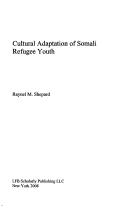| Listing 1 - 10 of 34 | << page >> |
Sort by
|

ISBN: 1283222434 9786613222435 9027283079 9789027283078 155619224X 9781556192241 9027238103 9789027238108 Year: 1999 Publisher: Amsterdam Benjamins
Abstract | Keywords | Export | Availability | Bookmark
 Loading...
Loading...Choose an application
- Reference Manager
- EndNote
- RefWorks (Direct export to RefWorks)
Somali is spoken by more than nine million people in the Horn of Africa and by expatriate communities in the Middle East, Europe and North America. It is the official language of Somalia and an important regional language in Ethiopia and Kenya. As a Cushitic language Somali is part of the great Afroasiatic language family whose other branches include Semitic, Berber, Chadic and Ancient Egyptian. This book provides a comprehensive description of the grammar of the language that will be of interest to non-specialists and linguists interested in typology and language comparison. The author's acce
Book
ISBN: 0252099451 9780252099458 9780252040931 0252040937 0252082419 Year: 2017 Publisher: Urbana, Chicago, Springfield, Illinois : University of Illinois Press,
Abstract | Keywords | Export | Availability | Bookmark
 Loading...
Loading...Choose an application
- Reference Manager
- EndNote
- RefWorks (Direct export to RefWorks)
Drawing on a wealth of ethnographic detail, Stephanie Bjork offer the first study on the messy role of clan or tribe in the Somali diaspora, and the only study on the subject to include women's perspectives. 'Somalis Abroad' illuminates the ways clan is contested alongside ideas of autonomy and gender equality, challenged by affinities towards others with similar migration experiences, transformed because of geographical separation from family members, and leveraged by individuals for cultural capital. Challenging prevailing views in the field, Bjork argues that clan-informed practices influence everything from asylum decisions to managing money. The practices also become a pattern that structures important relationships via constant - and unwitting - effort.
Somalis --- Somali diaspora. --- Diaspora, Somali --- Human geography --- Somal --- Somali --- Somalians --- Somals --- Cushites --- Ethnology --- Social life and customs. --- Diaspora --- Migrations
Book
ISBN: 1611863724 1609176464 1628954078 9781609176464 9781611863727 9781628954074 9781628964080 1628964081 Year: 2020 Publisher: East Lansing, Michigan
Abstract | Keywords | Export | Availability | Bookmark
 Loading...
Loading...Choose an application
- Reference Manager
- EndNote
- RefWorks (Direct export to RefWorks)
"The book is about the 2016 trial in Minneapolis of several Somali immigrant and Somali American men for trying to join ISIS. It examines the process of radicalization and the reasons why one of the young men chose to cooperate with the FBI and testify against his friends and family members"--
Trials (Terrorism) --- Somali Americans --- Social conditions. --- Ethnology --- Somalis --- Terrorism
Book
ISBN: 9780822374725 Year: 2016 Publisher: Durham : Duke University Press,
Abstract | Keywords | Export | Availability | Bookmark
 Loading...
Loading...Choose an application
- Reference Manager
- EndNote
- RefWorks (Direct export to RefWorks)
How do people whose entire way of life has been destroyed and who witnessed horrible abuses against loved ones construct a new future? How do people who have survived the ravages of war and displacement rebuild their lives in a new country when their world has totally changed? In Making Refuge Catherine Besteman follows the trajectory of Somali Bantus from their homes in Somalia before the onset in 1991 of Somalia’s civil war, to their displacement to Kenyan refugee camps, to their relocation in cities across the United States, to their settlement in the struggling former mill town of Lewiston, Maine. Tracking their experiences as "secondary migrants" who grapple with the struggles of xenophobia, neoliberalism, and grief, Besteman asks what humanitarianism feels like to those who are its objects and what happens when refugees move in next door. As Lewiston's refugees and locals negotiate co-residence and find that assimilation goes both ways, their story demonstrates the efforts of diverse people to find ways to live together and create community. Besteman’s account illuminates the contemporary debates about economic and moral responsibility, security, and community that immigration provokes.
Somali diaspora. --- Somalis --- Cultural assimilation --- Lewiston (Me.) --- Ethnic relations. --- Somal --- Somali --- Somalians --- Somals --- Cushites --- Ethnology --- Diaspora, Somali --- Human geography --- Diaspora --- Migrations --- Lewiston, Me. --- somali diaspora --- somalis --- cultural assimilation --- anthropology --- african studies
Multi
ISBN: 9780822374725 Year: 2016 Publisher: Durham : Duke University Press,
Abstract | Keywords | Export | Availability | Bookmark
 Loading...
Loading...Choose an application
- Reference Manager
- EndNote
- RefWorks (Direct export to RefWorks)
How do people whose entire way of life has been destroyed and who witnessed horrible abuses against loved ones construct a new future? How do people who have survived the ravages of war and displacement rebuild their lives in a new country when their world has totally changed? In Making Refuge Catherine Besteman follows the trajectory of Somali Bantus from their homes in Somalia before the onset in 1991 of Somalia’s civil war, to their displacement to Kenyan refugee camps, to their relocation in cities across the United States, to their settlement in the struggling former mill town of Lewiston, Maine. Tracking their experiences as "secondary migrants" who grapple with the struggles of xenophobia, neoliberalism, and grief, Besteman asks what humanitarianism feels like to those who are its objects and what happens when refugees move in next door. As Lewiston's refugees and locals negotiate co-residence and find that assimilation goes both ways, their story demonstrates the efforts of diverse people to find ways to live together and create community. Besteman’s account illuminates the contemporary debates about economic and moral responsibility, security, and community that immigration provokes.
Somalis --- Somali diaspora. --- Cultural assimilation --- Lewiston (Me.) --- Ethnic relations.
Book
ISBN: 0299303233 9780299303235 9780299303242 0299303241 Year: 2015 Publisher: Madison, Wisconsin The University of Wisconsin Press
Abstract | Keywords | Export | Availability | Bookmark
 Loading...
Loading...Choose an application
- Reference Manager
- EndNote
- RefWorks (Direct export to RefWorks)
Teenage refugees --- Refugees --- Somali American teenagers. --- Bantu-speaking peoples --- Somalis --- Refugee teenagers --- Teenagers, Somali American --- Teenagers --- Bantus --- Ethnology --- Somal --- Somali --- Somalians --- Somals --- Cushites --- Cultural assimilation --- Social life and customs.

ISBN: 1593323492 9781593323493 9781593322335 159332233X Year: 2008 Publisher: New York LFB Scholarly Pub.
Abstract | Keywords | Export | Availability | Bookmark
 Loading...
Loading...Choose an application
- Reference Manager
- EndNote
- RefWorks (Direct export to RefWorks)
Somali American teenagers --- Refugees --- Minorities --- Displaced persons --- Persons --- Aliens --- Deportees --- Exiles --- Teenagers, Somali American --- Teenagers --- Ethnic minorities --- Foreign population --- Minority groups --- Assimilation (Sociology) --- Discrimination --- Ethnic relations --- Majorities --- Plebiscite --- Race relations --- Segregation --- Cultural assimilation --- Ethnic identity --- Education --- Education (Secondary)
Book
ISBN: 1776147413 1776147391 Year: 2022 Publisher: Johannesburg : Wit University Press,
Abstract | Keywords | Export | Availability | Bookmark
 Loading...
Loading...Choose an application
- Reference Manager
- EndNote
- RefWorks (Direct export to RefWorks)
Citizen and Pariah explores the fragility of law, pluralism and democracy in South Africa by investigating Somali informal shopkeepers' experiences of crime, justice and regulation in the country. Through a narrative account of their local experiences, the book sheds light on the legal and political predicaments they face.
Somalis --- Stores, Retail --- Economic conditions. --- Commercial buildings --- Retail trade --- Shopping centers --- Retail stores --- Shops --- Cushites --- Ethnology --- Somal --- Somali --- Somalians --- Somals
Book
ISBN: 9780821445952 0821445952 9780821422588 0821422588 9780821422595 0821422596 0821445952 Year: 2017 Publisher: Athens
Abstract | Keywords | Export | Availability | Bookmark
 Loading...
Loading...Choose an application
- Reference Manager
- EndNote
- RefWorks (Direct export to RefWorks)
Though often associated with foreigners and refugees, many Somalis have lived in Kenya for generations, in many cases since long before the founding of the country
Somali diaspora. --- Somalis --- Nationalism --- Consciousness, National --- Identity, National --- National consciousness --- National identity --- International relations --- Patriotism --- Political science --- Autonomy and independence movements --- Internationalism --- Political messianism --- Somal --- Somali --- Somalians --- Somals --- Cushites --- Ethnology --- Diaspora, Somali --- Human geography --- Diaspora --- Migrations --- Kenya --- Cenia --- Chenia --- Colony and Protectorate of Kenya --- GOK --- Government of Kenya --- Jamhuri ya Kenya --- Kenia --- Kenii︠a︡ --- Kenniya --- Kenya Colony and Protectorate --- Ḳenyah --- Kīniyā --- Kīnyā --- Quênia --- Republic of Kenya --- Кения --- קניה --- كينيا --- ケニア --- 肯尼亚 --- East Africa Protectorate --- Ethnic relations --- History.
Book
ISBN: 1315430088 1315430096 1611327881 9781611327885 1598744909 9781598744903 9781598744903 9781598744910 1598744909 1598744917 9781315430096 9781315430065 9781315430072 131543007X Year: 2012 Publisher: Walnut Creek Left Coast Press
Abstract | Keywords | Export | Availability | Bookmark
 Loading...
Loading...Choose an application
- Reference Manager
- EndNote
- RefWorks (Direct export to RefWorks)
"Khat, marijuana, peyote--are these dangerous drugs or vilified plants with rich cultural and medical values? In this book, Lisa Gezon brings the drug debate into the 21st century, proposing criteria for evaluating psychotropic substances. Focusing on khat, whose bushy leaves are an increasingly popular stimulant and the target of vehement anti-drug campaigns, she explores biocultural and socioeconomic contexts on local, national, and global levels. Gezon provides a multidisciplinary examination of the plant's direct physical and psychological effects, as well as indirect social and structural effects on income and labor productivity, identity, gendered relationships, global drug discourses, and food security. This sophisticated, multileveled analysis cuts through the traditional battle lines of the drug debate and is a model for understanding and evaluating psychotropic substances around the world"--
Khat --- Abyssian tea plant --- Arabian tea plant --- Catha edulis --- Kat --- Miraa --- Qat --- Sallaa --- Somali tea plant --- Catha --- Psychotropic plants --- Social aspects. --- Economic aspects. --- Political aspects.
| Listing 1 - 10 of 34 | << page >> |
Sort by
|

 Search
Search Feedback
Feedback About UniCat
About UniCat  Help
Help News
News